The Ancient Order of the Hibernians (A.O.H) and the Orangmen both started at Smith College as secret societies in the late 19th century and carried a rivalry with one another until secret societies were stopped at Smith by President Davis in 1948, though both groups continued activities into the early 1960s [1]. A member of the Class of 1895 who was an original member of the A.O.H stated that she believed the group was founded during her sophomore year of college, but the College Archives finding aid states the group was founded in 1890 [2]. The College Archives also place the Orangemen’s founding, the rival society of the AOH, in 1890 [3]. The A.O.H was based on an Irish Roman Catholic fraternal order, the Ancient Order of the Hibernians while the Orangemen were based on an Irish Protestant group, the Loyal Orange Association. Both of the original groups dated back quite a bit, the Hibernians going back to the 1500s and the Orangemen dating back to 1795 Ireland [4]. The Ancient Order of the Hibernians was the biggest Irish fraternal order in the US and was made up by “practicing Catholics of Irish descent.” [5]
In her recollections of the A.O.H, Alice Martin Turner ‘95, an original founding member stated that the group wrote to the National Ancient Order of the Hibernians “suggesting that we join their organization,” but were rejected as the Order only accepted men.[6] Around the same time that Smithies boldly wrote this letter to the national A.O.H, the Ladies’ Auxiliary of the Ancient Order of the Hibernians (LAAOH) formed in 1894. The LAAOH “fought to build up the order, even as men resisted their involvement, and that they did not shy away from exercising political influence.”[7] Still, the Smith students sought to be a part of the A.O.H, they seemingly did not have an interest in being part of a women’s auxiliary.
This does bring to mind questions about the intent of the A.O.H at Smith College, did they want to follow the lead of the national organization and promote their causes, or did they simply appropriate the name for their own use?
What does that say about these students at Smith College, which had just been recently founded?
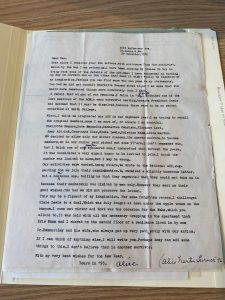
The A.O.H was dedicated as a society to “the maintenance of devilish wit and the promotion of hellish spirit in the college.” [8] They were intent in their rebellion as an organization, operating as a secret society and as an unsanctioned branch of a group only for men. The A.O.H kept a scrapbook, conducted initiations for new members, and was seemingly well known at Smith as they appear in the yearbooks and there are articles about them in Smith College Associated News documenting their activities and the ensuing controversies about them. [9]
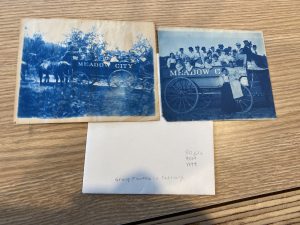
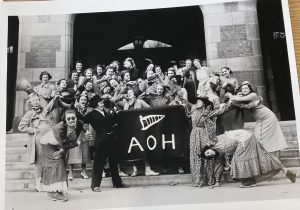
What does the creation of this group say about the early years of Smith College students? How did the identity of the group seem to shift over time based on these pictures?
The Orangemen did similar activities as the A.O.H. They wrote songs and also wore their cloaks to parade around campus in orange hats.[10] The cloaks are visible in the picture below.
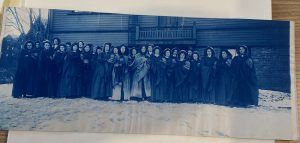
Similar to the A.O.H, in 1986 a former Orangemen member wrote about her memories of the Orangemen and how the archivists at Smith College were collecting information about the society. She stated, “we had fun but it was all nonsense.”[11]
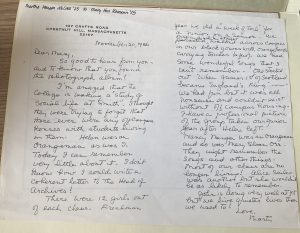
What does it mean for these secret societies to be documented in the institutional archives and in mainstream Smith College publications? Are they still a secret?
The Orangemen and A.O.H also kept up a rivalry between themselves for years. In 1944, the Orangemen stole the A.O.H scrapbook and left their graffiti on it to note that they had overtaken the A.O.H in this way. Both groups were ended at the same time by President Davis, but coexisted in what the Smith College Archives calls an “intense rivalry” and an “intense but friendly competition.” [12]
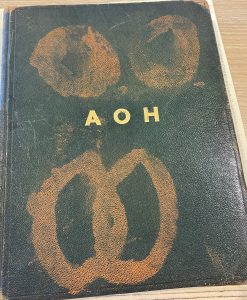
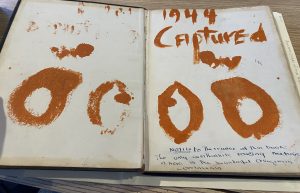
How does the presence of these groups for close to 60 years of Smith College’s history change or affirm your preconceived notions of early Smith College students? Does this change how you view early Smithies? Are you surprised by this history?
Endnotes
- “Collection: Ancient Order of Hibernians Records,” Smith College Finding Aids, accessed March 3, 2022, https://findingaids.smith.edu/repositories/4/resources/145; “Orangemen, C1908-1936, 1986 | Smith College Finding Aids,” accessed March 27, 2022, https://findingaids.smith.edu/repositories/4/archival_objects/14825.
- Alice Martin Turner ’95 to “Nan” December 29, 1961, Correspondence, St. Patrick’s Day Letters, 1926-1956, undated, Ancient Order of the Hibernians Records, Box 3011.1, College Archives, Smith College, Northampton, MA; “Collection: Ancient Order of Hibernians Records,” Smith College Finding Aids, accessed March 3, 2022, https://findingaids.smith.edu/repositories/4/resources/145.
- “Orangemen, C1908-1936, 1986 | Smith College Finding Aids.”
- “Orangemen, C1908-1936, 1986 | Smith College Finding Aids”; “Collection: Ancient Order of Hibernians Records.”
- Tara M McCarthy, “A Monumental Mission: The Ancient Order of Hibernians Women and the Construction of History, 1894–1918” 16 (2021): 4.
- Alice Martin Turner ’95 to “Nan” December 29, 1961, Correspondence, St. Patrick’s Day Letters, 1926-1956, undated, Ancient Order of the Hibernians Records, Box 3011.1, College Archives, Smith College, Northampton, MA.
- McCarthy, “A Monumental Mission: The Ancient Order of Hibernians Women and the Construction of History, 1894–1918,” 3.
- “Collection: Ancient Order of Hibernians Records.”
- “Collection: Ancient Order of Hibernians Records”; Examples: “Secret Societies to Continue; To Take Only Upperclassmen,” Smith College Associated News, September 24, 1943, Vol 39, no 2 edition, Smith College Weekly 34 1943-1944 Bound; Smith College, Class of 1904 Classbook (Smith College, 1904), 67–69, http://archive.org/details/class1904smit.
- “Orangemen, C1908-1936, 1986 | Smith College Finding Aids.”
- Martha Housen McCrea ’25 to Mary Foss Hamann ’25, November 20, 1986. Orangemen Correspondence, 1941-86, Student Club and Organizations, Box 3004.4, College Archives.
- “Orangemen, C1908-1936, 1986 | Smith College Finding Aids”; “Collection: Ancient Order of Hibernians Records.”
Annotated Bibliography
McCarthy, Tara M. “A Monumental Mission: The Ancient Order of Hibernians Women and the Construction of History, 1894–1918” 16 (2021): 21.
This article was utilized in this exhibit. It is about the Ladies’ Auxiliary of the Ancient Order of the Hibernians. As noted, the Smith chapter was not a Ladies’ Auxiliary, which is interesting and this article will help illuminate what opportunities were available to other women in this group and to understand how it operated for women.
Crane, Mackenzie. “The Tap: An Examination of the Controversy of Secret Societies on College Campuses.” M.Ed., University of South Carolina. Accessed February 23, 2022. https://www.proquest.com/docview/1686533113/abstract/D4670441DD84592PQ/1.
This article is useful for understanding secret societies. Crane defines secret societies, “A collegiate secret society refers to an intentional, persistent social network of students and alumni whose activities (Erickson, 1981), purposes, and sometimes membership (“Secret society”, 2013) are revealed only to those who belong. Entrance to such organizations is by invitation only, as opposed to by free choice by any interested party. Therefore, they maintain an inherent exclusionary quality (Graebner, 1987). These groups are characterized by a profound confidence among members that secret proceedings will be fiercely guarded from those outside the group (Hazelrigg, 1969)(Crane 1).”
Clawson, Mary Ann. “Nineteenth-Century Women’s Auxiliaries and Fraternal Orders.” Signs 12, no. 1 (1986): 40–61. https://www.jstor.org/stable/3174356.
While not utilized in this exhibit, this article is about fraternal orders. This is useful in understanding fraternal orders and their relationships to women, although it does not include the Ancient Order of the Hibernians. Clawson defines fraternal orders: “1) Fraternal orders are fictive kinship groups, which conceive of themselves as brotherhoods. (2) They use ritual, especially that of the initiation rite, to construct and sustain the fraternal bond. (3) They typically exclude women from membership and make this exclusion a central part of their organizational identity” (41).
Further Research
Ancient Order of the Hibernians Records. College Archives, Smith College, Northampton, MA, https://findingaids.smith.edu/repositories/4/resources/145/collection_organization.
Cuomo, Rosalind S. “Very Special Circumstances :: Women’s Colleges and Women’s Friendships at the Turn of the Century.” University of Massachuesetts, 1988. https://scholarworks.umass.edu/cgi/viewcontent.cgi?article=2566&context=theses.
Domagal, Jennifer. “Keeping Secrets: Student Secret Societies in Historical Context.” The Vermont Connection 23, no. 1 (2002). https://scholarworks.uvm.edu/tvc/vol23/iss1/6/?utm_source=scholarworks.uvm.edu%2Ftvc%2Fvol23%2Fiss1%2F6&utm_medium=PDF&utm_campaign=PDFCoverPages.
Gastellum, Melissa. “Girls Just Want to Have Fun: A Brief Overview of Two Secret Societies at Smith.” Class: Forms of Writing, December 12, 1944. Box 1. Undergraduate Research Papers Collection.
Horowitz, Helen Lefknowitz. Alma Mater: Design and Experience in the Women’s Colleges from Their Nineteenth Century Beginnings to the 1930s. 2nd ed. Amherst: University of Massachusetts Press, 1993.
“Omega Society, c1910.” Student Clubs and Organizations, Box: 3004.4. College Archives, Smith College, Northampton, MA 01063. https://findingaids.smith.edu/repositories/4/archival_objects/14823.
Orangemen, c1908-1936, 1986. Student Club and Organizations, Box 3004.4. College Archives, Smith College, Northampton, MA. https://findingaids.smith.edu/repositories/4/archival_objects/14825.
“Phi Beta Kappa, 1972.” Student Clubs and Organizations, Box: 3004.4. College Archives, Smith College, Northampton, MA 01063. https://findingaids.smith.edu/repositories/4/archival_objects/14832
Piper, P. P. “Secret Societies in Women’s Colleges.” Harper’s Bazaar. New York, United States: Hearst Magazine Media, Inc, October 1901. https://www.proquest.com/docview/1914175811/abstract/D184397D7A8C4EA1PQ/1.
Smith College Finding Aids. https://findingaids.smith.edu/repositories/4/archival_objects/14825
SCAN (), 1940-1952. Student Publications and Student Publications Records. College Archives, Smith College, Northampton, MA. https://findingaids.smith.edu/repositories/4/archival_objects/411990
Smith College Finding Aids. “Collection: Ancient Order of Hibernians Records.” Accessed March 3, 2022. https://findingaids.smith.edu/repositories/4/resources/145.
“Thistle Club, 1930s.” Student Clubs and Organizations, Box: 3004.8. College Archives, Smith College, Northampton, MA 01063. https://findingaids.smith.edu/repositories/4/archival_objects/14902.
“Thistle Club-Tartan and Cap, undated.” Student Clubs and Organizations, Box: 3004.8. College Archives, Smith College, Northampton, MA 01063. https://findingaids.smith.edu/repositories/4/archival_objects/14903
McCarthy, Tara M. “A Monumental Mission: The Ancient Order of Hibernians Women and the Construction of History, 1894–1918” 16 (2021): 21.
“Orangemen, C1908-1936, 1986 | Smith College Finding Aids.” Accessed March 27, 2022. https://findingaids.smith.edu/repositories/4/archival_objects/14825.
“Senior Members of the Ancient Order of Hibernians, Smith College Class Book, 1905. · Smith Libraries Exhibits.” Accessed February 11, 2022. https://libex.smith.edu/omeka/items/show/361.
Smith College Associated News. “Secret Societies to Continue; To Take Only Upperclassmen.” September 24, 1943, Vol 39, no 2 edition. Smith College Weekly 34 1943-1944 Bound.
Smith College. Class of 1904 Classbook. Smith College, 1904. http://archive.org/details/class1904smit.
“Smith College Libraries.” Internet Archive. https://archive.org/browse.php?field=subject&mediatype=texts&collection=smithcollege